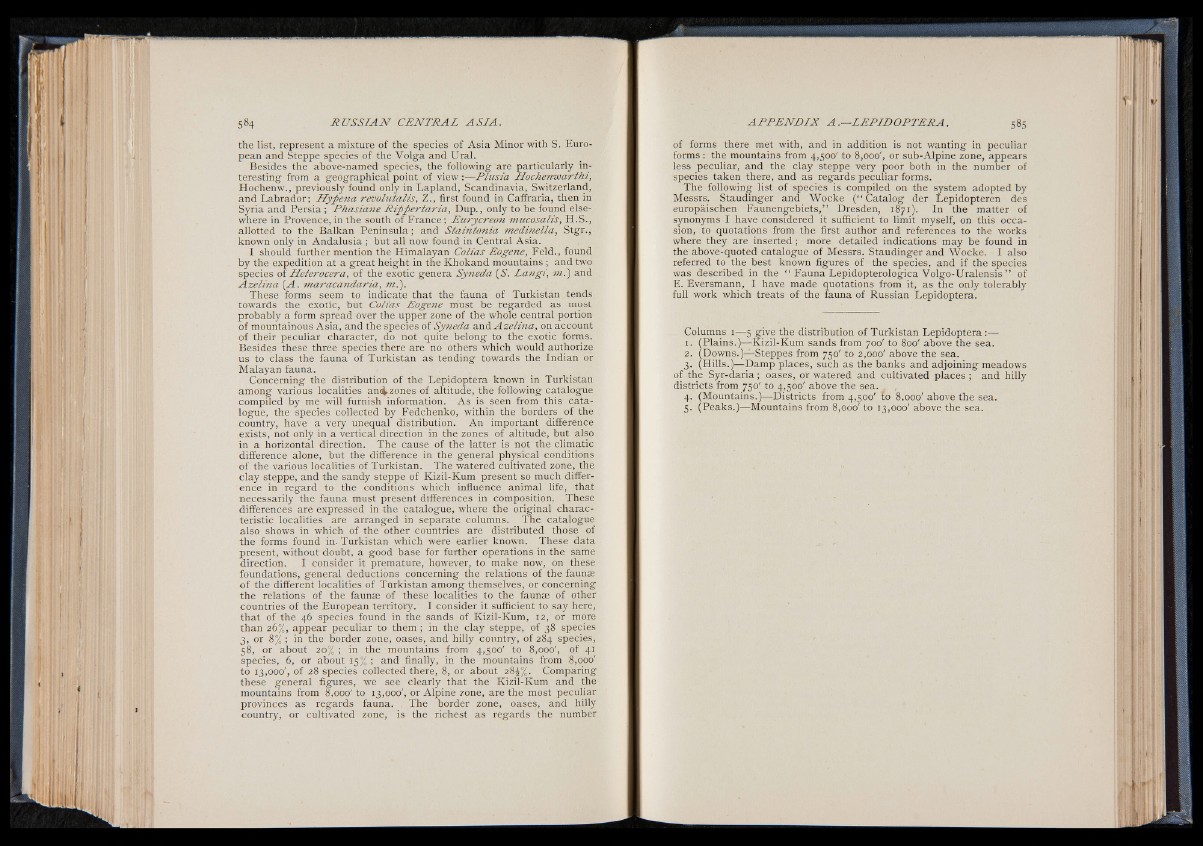
the list, represent a mixture of the species of Asia Minor with S. European
and Steppe species of the Volga and Ural,
Besides the above-named species, the following are particularly interesting
from a geographical point of view :—Plusia Hochenwarthi,
Hochenw., previously found only in Lapland, Scandinavia, Switzerland,
and Labrador; Hyaena revolutalis, Z., first found in Caffraria, then in
Syria and Persia; Pkasiane Rififtertaria, Dup., only to be found elsewhere
in Provence, in the south of France; Eurycreon mucosalis, H.S.,
allotted to the Balkan Peninsula; and Staintonia medinella, Stgr.,
known only in Andalusia ; but all now found in Central Asia.
I should further mention the Himalayan Colias Eogene, Feld., found
by the expedition at a great height in the Khokand mountains ; and two
species of Heterocera, of the exotic genera Syneda (S. Langi, ml) and
Azelina (A . maracandaria, m.).
These forms seem to indicate that the fauna of Turkistan tends
towards the exotic, but Colias Eogene must be regarded as most
probably a form spread over the upper zone of the whole central portion
of mountainous Asia, and the species of Syneda and Azelina, on account
of their peculiar character, do not quite belong to the exotic forms.
Besides these three species there are no others which would authorize
us to class the fauna of Turkistan as tending towards the Indian or
Malayan fauna.
Concerning the distribution of the Lepidoptera known in Turkistan
among various localities an<^ zones of altitude, the following catalogue
compiled by me will furnish information. As is seen from this catalogue,
the species collected by Fedchenko, within the borders of the
country, have a very unequal distribution. An important difference
exists, not only in a vertical direction in the zones of altitude, but also
in a horizontal direction. The cause of the latter is not the climatic
difference alone, but the difference in the general physical conditions
of the various localities-of Turkistan. The watered cultivated zone, the
clay steppe, and the sandy steppe of Kizil-Kum present so much difference
in regard to the conditions which influence animal life, that
necessarily the fauna must present differences in composition. These
differences are expressed in the catalogue, where the original characteristic
localities are arranged in separate columns. The catalogue
also shows in which of the other countries are distributed those of
the forms found in. Turkistan which were earlier known. These data
present, without doubt, a good base for further operations in the same
direction. I consider it premature, however, to make now, on these
foundations, general deductions concerning the relations of the faunae
of the different localities of Turkistan among themselves, or concerning
the relations of the faunae of these localities to the faunae of other
countries of the European territory. I consider it sufficient to say here,
that of the 46 species found in the sands of Kizil-Kum, 12, or more
than 26%, appear peculiar to them ; in the clay steppe, of 38 species
3, or 8% ; in the border zone, oases, and hilly country, of 284 species,
58, or about 20% ; in the mountains from 4,500' to 8,000', of 41
species, 6, or about 15% ; and finally, in the mountains from 8,000'
to 13,000', of 28 species collected there, 8, or about 2 8 Comparing
these general figures, we see clearly that the Kizil-Kum and the
mountains from 8,ooo' to 13,000', or Alpine zone, are the most peculiar
provinces as regards fauna. , The border zone, oases, and hilly
country, or cultivated zone, is the richest as regards the number
of forms there met with, and in addition is not wanting in peculiar
forms : the mountains from 4,500' to 8,000', or sub-Alpine zone, appears
less peculiar, and the clay steppe very poor both in the number of
species taken there, and as regards peculiar forms.
The following list of species is compiled on the system adopted by
Messrs. Staudinger and Wocke (“ Catalog der Lepidopteren des
europäischen Faunengebiets,” Dresden, 1871). In the matter of
synonyms I have considered it sufficient to limit myself, on this occasion,
to quotations from the first author and references to the works
where they are inserted ; more detailed indications may be found in
the above-quoted catalogue of Messrs. Staudinger and Wocke. I also
referred to the best known figures of the species, and if the species
was described in the “ Fauna Lepidopterologica Volgo-Uralensis ” of
E. Eversmann, I have made quotations from it, as the only tolerably
full work which treats of the fauna of Russian Lepidoptera.
Columns 1—5 give the distribution of Turkistan Lepidoptera:—
1. (Plains.)— Kizil-Kum sands from 700' to 800' above the sea.
2. (Downs.)— Steppes from 750' to 2,000' above the sea.
3. (Hills.)—Damp places, such as the banks and adjoining meadows
of the Syr-daria; oases, or watered and cultivated places ; and hilly
districts from 750' to 4,500' above the sea.
4. (Mountains.^Districts from 4,500' to 8,000' above the sea.
5. (Peaks.)—Mountains from 8,000' to 13,000' above the sea.